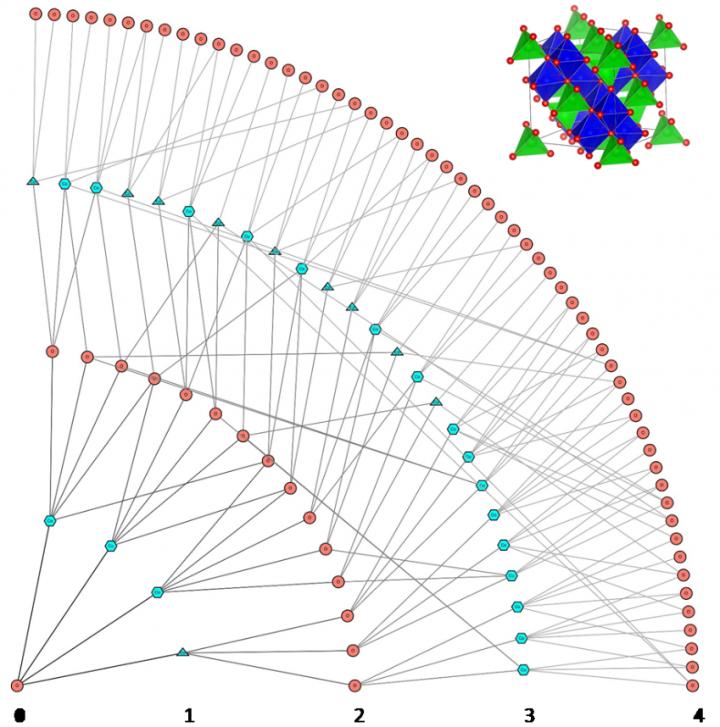A new paradigm of material identification based on graph theory

The simplified graph and the actual crystal structure (upper right) of spinel Co3O4. Credit: Science China Press
Feng Pan and his colleagues, from Peking Univerisy Shenzhen Graduate School, propose a new paradigm based on graph theory (GT scheme) to improve the efficiency and accuracy of material identification, which focuses on processing the “topological relationship” rather than the value of bond length and bond angle among different structures.
In GT scheme, the researchers first simplify crystal structures into a graph, which only consists of vertices and edges, in which atoms are simplified as vertices and adjacent atoms with the actual chemical bonds are “connected” with edges.
If the topological connections in the simplified graphs between two structures are the isomorphic, the GT scheme will consider them as one structure. By using this method, automatic deduplication for big materials database is achieved for the first time, which identifies 626,772 unique structures from 865,458 original structures.
Moreover, the GT scheme has been modified to solve some advanced problems such as identifying highly distorted structures, distinguishing structures with strong similarity and classifying complex crystal structures in materials big data.
Compared with the traditional structure chemistry methods, the GT scheme can address these iusses much more easily, which enhances the efficiency and reliability of material identification.
By using this artificial intelligent technique, the researchers are trying to achieve high-throughput calculation, preparation and detection for the materials database. The GT scheme subverts the traditional material research methods and accelerates the development in material research field.
###
This work “Identify crystal structures by a new paradigm based on graph theory for building materials big data” has been published in SCIENCE CHINA Chemistry, and the paper is available online at: https:/
The authors thank Dr. Lin-Wang Wang from Lawrence Berkeley National Laboratory and Dr. Wenfei Fan from the University of Edinburgh for their helpful discussions. This work was supported by the National Key R&D Program of China (2016YFB0700600), the National Natural Science Foundation of China (21603007, 51672012), Soft Science Research Project of Guangdong Province (2017B030301013), and New Energy Materials Genome Preparation & Test Key-Laboratory Project of Shenzhen (ZDSYS201707281026184).
See the article: Mouyi Weng, Zhi Wang, Guoyu Qian, Yaokun Ye, Zhefeng Chen, Xin Chen, Shisheng Zheng, Feng Pan. Identify crystal structures by a new paradigm based on graph theory for building materials big data. Sci. China Chem., 2019, doi: 10.1007/s11426-019-9502-5
Media Contact
More Information:
http://dx.doi.org/10.1007/s11426-019-9502-5All latest news from the category: Materials Sciences
Materials management deals with the research, development, manufacturing and processing of raw and industrial materials. Key aspects here are biological and medical issues, which play an increasingly important role in this field.
innovations-report offers in-depth articles related to the development and application of materials and the structure and properties of new materials.
Newest articles

Silicon Carbide Innovation Alliance to drive industrial-scale semiconductor work
Known for its ability to withstand extreme environments and high voltages, silicon carbide (SiC) is a semiconducting material made up of silicon and carbon atoms arranged into crystals that is…

New SPECT/CT technique shows impressive biomarker identification
…offers increased access for prostate cancer patients. A novel SPECT/CT acquisition method can accurately detect radiopharmaceutical biodistribution in a convenient manner for prostate cancer patients, opening the door for more…

How 3D printers can give robots a soft touch
Soft skin coverings and touch sensors have emerged as a promising feature for robots that are both safer and more intuitive for human interaction, but they are expensive and difficult…





















